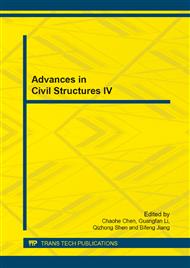p.732
p.736
p.741
p.745
p.751
p.757
p.762
p.767
p.772
Numerical Simulation on the Mechanical Performance of the Wind Generator Latticed Concrete-Filled Steel Tubular Tower
Abstract:
Nonlinear finite element parameters analysis on the lattice type steel pipe concrete wind turbine tower, it shows the entire process of load bearing, failure mode and ultimate bearing capacity, researches on the influence law of aspect ratio, form of tower webs, tower diameter to thickness ratio and web member stiffness to tower column stiffness ratio on the ultimate bearing capacity and tower failure mode. The finite element analysis results shows that the tower aspect ratio λ, the diameter-thickness ratio γ of tower columns and the increase of stiffness ratio β between web members and tower columns has great influence on ultimate bearing capacity and failure mode, while the form of webs has small influence on that. with the increase of tower aspect ratio λ, the decrease of diameter-thickness ratio γ of tower columns and the increase of stiffness ratio β between web members and tower columns, the ultimate bearing capacity of this kind of latticed towers increase, the failure mode changed from Web local buckling to The combined damage of Web local buckling and the tension tower yield. This paper suggests that in the design of wind turbulent generator tower, the tower aspect ratio λ should be best controlled at 1/9, the bottom layers of this kind of tower should best use the re-divided web members, and other web member forms used on above layers, the diameter-thickness ratio γ of tower column should be taken less than 30, and the stiffness ratio β between webs and columns should be controlled less than 0.05 in order to avoid damage occurring on the tower columns earlier than the webs. The results can provide evidence for the engineering design.
Info:
Periodical:
Pages:
751-756
Citation:
Online since:
July 2014
Authors:
Price:
Сopyright:
© 2014 Trans Tech Publications Ltd. All Rights Reserved
Share:
Citation:


